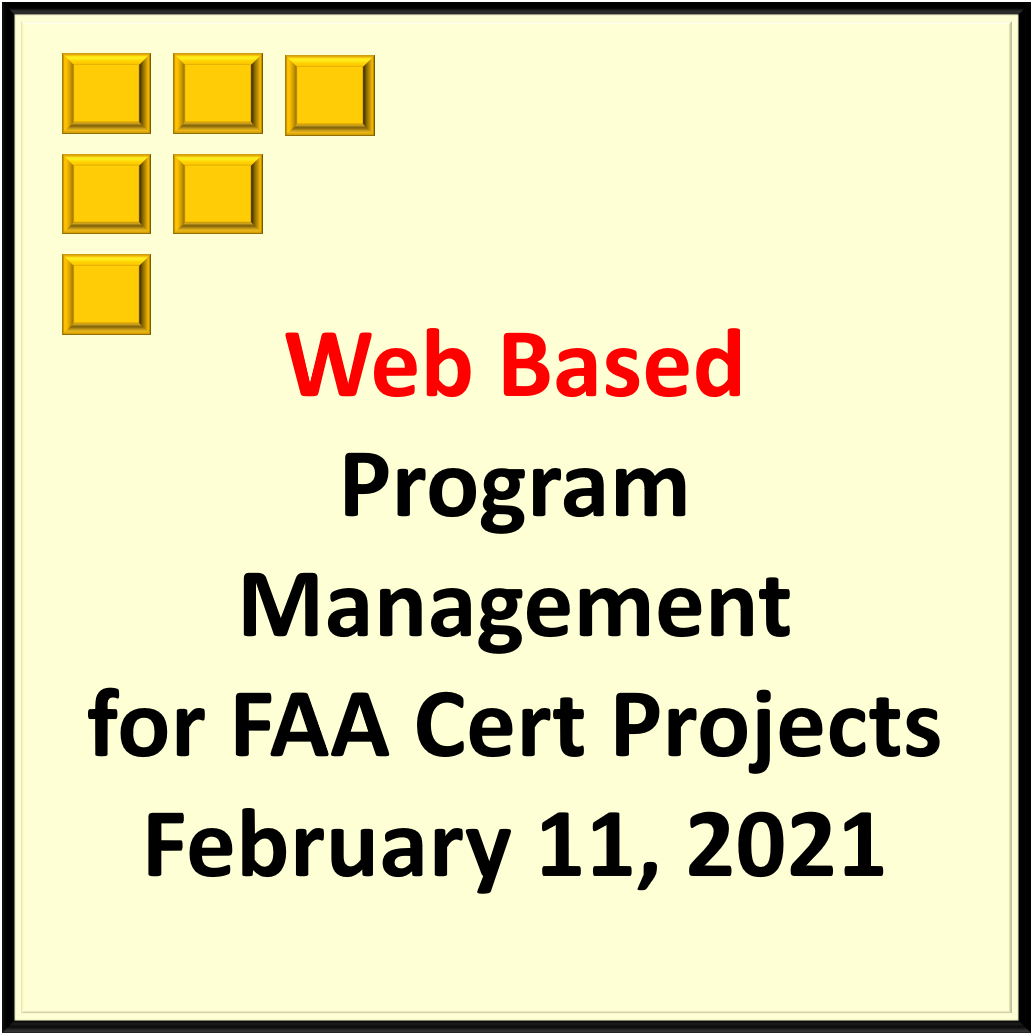Description
February 11, 2021
This is a half-day, live, web-based training course that is structured for persons that may be new to FAA certifications or for those who have previous experience and wish to expand their management skills. By nature, FAA certifications projects are difficult to management, but there are some key tools that can make the task more organized and successful. This seminar examines 12 Tools for Certification Managers. One could also call it “Tips from Guys That Have Done It Before”. Like any tip, use the ones that are appropriate for your project… but all the following items need to be addressed somehow in all certifications…
Drake web-based half-day training is intended to introduce the subjects to attendees. The training is conducted totally online with live instructors. The scheduling of the web training is East Coast 12 PM – 4 PM and West Coast 9 AM – 1 PM. This schedule allows attendees to be available at work for a half day and in training for a half day.
The training will be conducted via WebEx and can be accessed from work or at home via internet. Attendees receive log-on information after sign-up. WebEx sessions are started half an hour in advance of start time for attendee convenience. Attendees receive a PDF file of key slides ahead of time. Attendees may ask limited questions periodically during the session. Attendees receive a training certificate emailed after completion of the session.
Drake does offer private web-based training sessions for individual companies that allow for open discussion to a specific project. Drake can sign an NDA prior to this if required.
Below is a summary of topics.
TOOL #1 THE SPECIFICATION
We start with a session regarding the need to have a written specification or TC STC PMA project description… simple ones for simple projects and more voluminous for bigger projects… but we need one to keep us organized and all on the same track. We will look at some examples.
TOOL #2 DER / DAR / ODA STAFF & PROJECT ADVISERS
While this subject was addressed earlier we stress the need to pick out good DERs, DARs, ODAs and project advisers. Managing the efforts of these FAA designees is sometimes difficult. We present some techniques that may be beneficial in organizing and monitoring the efforts of these FAA representatives.
TOOL #3 COMPLIANCE CHECKLIST
The compliance checklist are the detail regulations we must address and how we plan to show compliance for each one to the FAA offices. We will look at some simple checklists and some more complex formats. We also review why the FAA considers this document so important.
TOOL #4 MDL / MRL
The master drawing list and the master report list is a management tool for both the project manager and the FAA offices. We examine how the MDL/MRL evolves from an early planning document to a final report with exact detail.
TOOL #5 SCHEDULE
A certification schedule, like most project schedule, probably causes the most ulcers than any single certification element. We analyze how to structure a schedule for a certification project and how not to….
TOOL #6 BUDGET
A close second in the ulcer department next to schedules, budgets for certification projects are less traumatic if created in detail. We show a way of generating a budget that has a better chance at getting the job done.
TOOL #7 PSCP
With the previous items started, we can now draft a PSCP, a Project Specific Certification Plan. We look at what should be in a PSCP and how the FAA regards this document. We also look at who needs to sign the document.
TOOL #8 CONFORMITY PLAN
Sometimes a subset of the previous PSCP, the conformity plan is probably the most mis-executed part of certification for new FAA applicants. We review what should be in a conformity plan in terms of line items, persons, locations conformity requests and delegations. Even the “big boys” with lots of cert experience stumble on this issue of conformity from time to time.
TOOL #9 CONFORMITY TRACKING
While this is a subset of the previous conformity plan, conformity inspection tracking is worthy of its own session. A project can have a beautiful plan but the secret is in the tracking of the plan throughout the project. We look at some ways to track our many conformities… both in house and at our suppliers.
TOOL #10 FAA SUBMITTAL TRACKING
Keeping tracked of what paperwork is being sent to the FAA and the status is a full time job on some larger projects. It is, at minimum, a job that someone must step up to on smaller projects. We examine how FAA submittal tracking can aid both the applicant and the FAA program manager.
TOOL #11 WEEKLY STATUS REPORTS
We all hate them, but periodic status reports are necessary when we have a lot of people working on a complex project. There are simple ways of making the job of creating the status report easy such that they can be created even if you are away for a few days.
TOOL#12 COMMUNICATIONS TO PROJECT MEMBERS
Communication between two people is hard enough… communication on a complex project between numerous people, in numerous locations, with numerous organizations can be single element that makes a certification project able to handle changes as they appear. We offer tips that can reduce the “communication gap”.

